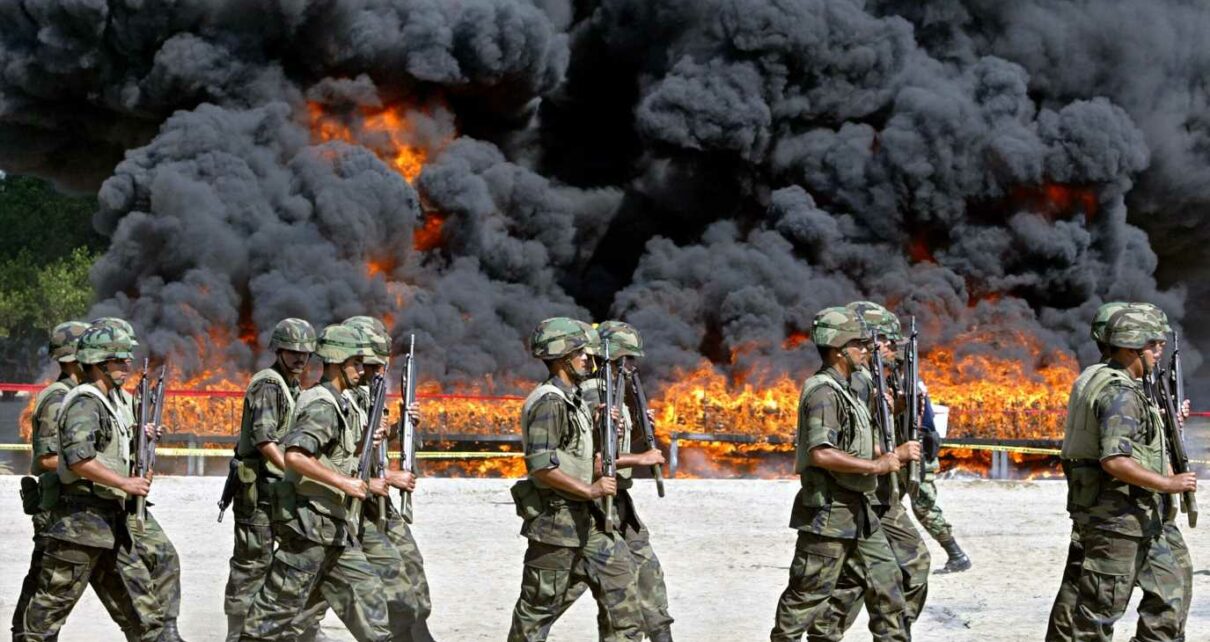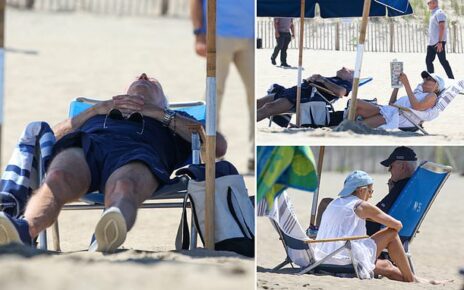STEPPING over a dead body, a local barely bats an eyelid as the blood slowly spreads over the pavement and road.
Elsewhere, the sound of rapid gunfire drowns out conversation, but not a single person pays attention.


This is day-to-day life in Colima, the most deadly city in the world, according to a new report by The Citizen Council for Public Security and Criminal Justice (CCPSCJ) in Mexico.
The 330,000 person-strong city is being ripped apart by violent cartel turf wars, and last year recorded a shocking rate of 182 homicides per 100,000 inhabitants.
In total, 601 lives – many of them innocent civilians – were deliberately taken as drug lords battle for territory of the city and Mexican state with the same name.
Last year, British software engineer Ben Corser, 37, was gunned down while shopping at a supermarket with three pals in Colima City and is thought to have been a victim of the cartels.
READ MORE FEATURES

Crumbling ruins of hotels prove council has let our seaside town go to the dogs

Our town is dying thanks to £1 nightmare… you even have to pay to go church
He was killed alongside two friends, Claudio and Alfredo. His devastated family said he was “in the wrong place at the wrong time”.
In January this year, 70 people were intentionally killed in the city, including a university student who played American football, a doctor from the State Institute of Oncology, and a 16-year-old boy.
Colima City is hotly contested by three different gangs due to its proximity to the port town of Manzanillo, which has become a Western gateway for organised crime.
Controlling the capital means the drug kingpins can control the rest of the state.
Most read in The Sun
 ENDER THE ROAD
ENDER THE ROAD
Enders in crisis as Brian Conley quits to leave key storyline in tatters
 CUTTING EDGE
CUTTING EDGE
BBC radio DJ in on-air rant during final show which bosses tried to silence
 RIPPED APART
RIPPED APART
I thought I’d die when I was mauled by savage XL Bully, girl, 11, reveals
 TV TRIBUTE
TV TRIBUTE
Holly and Dermot’s touching tribute after sudden death of This Morning favourite
It was once the safest place to live in Mexico, with almost all inhabitants having access to electricity, running water and a sewage system.
Even now, tourists still flock to the coast of Colima for the long sandy, bordered by luxurious Moor-style hotels which can cost up to £200 a night.
But in recent years, it has become the battleground for a power struggle between the Sinaloa Cartel, The Jalisco New Generation Cartel (CJNG), and Los Zetas.
And the rivalries have only intensified since the production of Fentanyl became a lucrative source of income for gangs.


Fentanyl boost for crime
Falko Ernst, senior Mexico analyst at the International Crisis Group, suggests the drug has become an ignition point for continued violence in the once sleepy-city.
“It’s definitely become a big driver of violence in Mexico,” Ernst said. “It’s a huge cash cow for those who have access to it.”
The ability to import the powerful drug in small packages means urban areas can be used for production – unlike growing poppies for opium.
Residents of the city and surrounding areas have told how their homes are being turned into 'fentanyl factories'.
More potent than heroin or cocaine, the synthetic drug is cheaper to produce and can sell for a higher price.
One worker, who fills around 21,000 capsules of the addictive substance a week, told The Irish Times they were paid around £264.
“It’s not a lot of money, but everywhere pays so little. It’s boring, too,” said one of the masked men, who were making the drugs for the Sinaloa Cartel.
Contested port access

Fentanyl production in Mexico has skyrocketed and, according to Mexican Defence Secretary Luis Cresencio Sandoval, meth seizures rose from 60 tons in 2016-2018 to almost 137.5 tons in 2019-2021.
By July this year, authorities had already seized 124 tons.
This means the port of Manzanillo – just over an hour's drive from Colima – is more important than ever, because it welcomes 200 million container ships a year.
With more shipments arriving than any other port in Mexico, authorities are unable to search every single container, allowing gangs to more successful move their drugs on.
It is also perfectly positioned on smuggling routes, allowing cartels to quickly and easily move their wares over the border.
The base ingredients of fentanyl are much harder to detect than the poppy fields that once fuelled the drug industry in South America.
Many of the chemicals in the killer drug and meth have dual uses, and are needed for things like soap, cheese, and even epilepsy medication.
Gangland turf battles


However, the ease of distribution means ruthless gangland bosses are going head-to-head wherever they can for port access.
The Sinaloa Cartel, historically the biggest and most powerful in the country, is doing all it can to fight off rivals CJNG and local brawlers Los Zetas.
Things started becoming more violent a decade ago when Sinaloa set their sights on CJNG's Manzanillo turf after the gangs stopped being allies.
Comlia’s deadly cartels vying for control

Three different cartels are vying for control of Colima and the nearby port Manzanillo. Control of the port is critical for gangs trying to transport their drugs out of Mexico and into the US and the rest of the world.
The Sinaloa Cartel
Historically the biggest cartel in Mexico with operations across 22 of the 31 states. It is currently headed by Ismael Zambada García. The US attorney general estimates the cartel was responsible for shipping and distributing nearly 180 tonnes of cocaine and large amounts of heroin between 1990 and 2008. They have since moved into the fentanyl trade. They have a Colima wing known as Los Mezcales who are their key drug distributors in the city.
The Jalisco New Generation Cartel (CJNG)
Now the largest cartel in Mexico, and the current controllers of Colima and the port of Manzanillo. They are said to have cannibalised some of their victims. Their main drug trafficking is cocaine and methamphetamines. The cartel is headed by Nemesio Oseguera Cervantes ("El Mencho"), one of the most wanted drug lords in the world.
Los Zetas
The least well-known cartel vying for control of Colima and the nearby port. They are known for using "shock and awe" tactics such as torture, beheadings, and indiscriminate murder to show off their brutality. They are primarily drug traffickers but also dabble in sex and gun rackets. In a bid to show their power, they regularly massacre rival cartels – including one spree which saw 193 people killed.
Some of the countries biggest drug busts have come in the port.
In 2016, approximately 860 pounds of cocaine were seized as one cartel attempted to smuggle them out of the county in fridges.
A week before, 213 shipping containers of spicy salsa containing cocaine en route to Sinaloa state were intercepted. It is thought to have been around 13 tonnes.
In April, the Mexican navy seized 11,520 tequila bottles that were filled with liquid meth, amounting to around 10 tonnes of the drug.
Then three months later, 9.5 tonnes of liquid meth disguised as Mezcal were intercepted before they could ship to Australia.
In 2015, Sinaloa decided they wanted to make the region part of their territory and claimed to locals they would end the kidnapping and extortion that had become common in the state.
Things escalated when Jesus Alfredo Guzmán, the son of Sinaloa Kingpin Manzanillo, was kidnapped, allegedly by the CJNG.
While he was later released, it was just the beginning of the deadly war.
Grisly warnings


For Mexicans, killings of innocent people in the streets are just part of life in Colima, as the gangs battle for supremacy
“A young man was murdered about 100 metres from my house. They mistook him for someone selling drugs,” Joel Vargas told Al Jazeera in 2016.
“They also killed the owner of a car wash in my neighbourhood. I’d just left home when I heard the shots and moments later I saw the body lying on the street, covered with a sheet.”
Bags of decomposing body parts, public hangings and even severed heads in the street serve as warnings to rival cartels.
Early last year, tensions reached boiling point and a mass brawl between CJNG and Sinaloa broke out, landing members of both in the same prison.
The incarceration didn't stop the fighting, with ten inmates massacred and seven more injured as the two gangs battled behind bars.
During holy week last April, ten people were murdered in the state of Colima in just 48 hours, Mexico Daily Post reported.
The spate of crimes included a mutilated head being left on the street in Manzanillo, with a warning note from La Barredora, Sinaloa's armed wing, telling the CJNG not to invade their territory.
Three of the senseless killings, including a 12-year-old girl, took place in the capital Colima – following on from six there, the previous week.
Small communities overrun

It is not just the big cities in the state that are falling into lawless hands, but also smaller farming villages.
Tecoman, close to Manzanillo, has seen murder rates skyrocket and local police barely blink when multiple killings take place within hours of each other.
High-speed police chases of cartel members in cars are commonplace, with one recent episode ending with a crook yelling “Come and kill them all right now. Kill them” as he was arrested by cops
But locals are turning a blind eye when they can to the destruction.
Angela Hernandez moved to the sleepy town a decade ago before violence erupted and is bringing up her five-year-old son in the middle of a cartel war.
But despite the killings, she doesn't feel worried about her family's safety.
“It really only touches those involved in the world of crime,” she told the New York Times.
Read More on The Sun

Mum spends benefits on designer school shoes for kid only for them to be banned

Kate Garraway reveals heartbreaking reason she kept hospital dash secret
She seems unfazed by the violence her son is growing up surrounded by.
“It’s better he gets used to it,” she said as her son climbed a gazebo railing nearby. “This is not going to change. None of it.”
Source: Read Full Article

